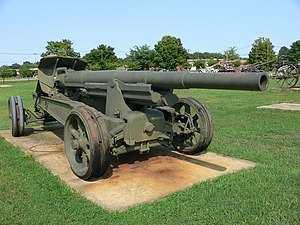155 mm gun M1918
| Canon de 155 GPF mle.1917 | |
|---|---|

155 mm GPF gun in travel position at US Army Ordnance Museum
|
|
| Type | Field gun, Coastal artillery |
| Place of origin | France |
| Service history | |
| In service | 1917–1945 |
| Used by | France United States Nazi Germany Philippines Australia Imperial Japan Finland Free Poland Brazil Chile |
| Wars |
World War I World War II |
| Production history | |
| Designer | Colonel Louis Filloux |
| Specifications | |
| Weight | Travel: 13,000 kg (28,660 lbs) |
| Barrel length | 5.915 m (20 ft) L/38.2 |
|
|
|
| Shell | separate-loading, cased charge. 43 kg (95 lb) |
| Caliber | 155 mm (6.10 in) |
| Recoil | 1.8m 10° to 1.1 28° |
| Carriage | split trail |
| Elevation | 0° to +35° |
| Traverse | 60° |
| Rate of fire | 2 rpm |
| Muzzle velocity | 735 m/s (2,411 ft/s) |
| Maximum firing range | 19,500 m (21,325 yds) |
The Canon de 155 Grande Puissance Filloux (GPF) mle.1917 was a 155 mm cannon used by the French Army during the first half of the 20th century.
The gun was designed during World War I by Colonel Louis Filloux to meet France's urgent need for modern heavy artillery, and became the standard heavy field gun of the French Army from 1917 until World War II. It was also adopted by the United States as the M1917, and a close derivative of it was made in and used by the US as the M1918 through World War II.
It was also manufactured in the USA from 1917, after the US switched to metric artillery based on French patterns. It was used by the United States Army and United States Marine Corps as their primary heavy artillery gun under the designation 155 mm Gun M1917 (French-made) or M1918 (US-made) until 1942, when it was gradually replaced by the 155 mm M1A1 'Long Tom'. US Army forces in the Far East (USAFFE) such as the 301st FA Regiment (Philippine Army) and the 86th FA Regiment (Philippine Scouts), and also US Coast Artillery units (91st and 92nd CA Regiments, Philippine Scouts) used this artillery piece against the Japanese invasion of the Philippines in 1941-42. Some of the guns were originally emplaced in "Panama mounts" on Corregidor, Caballo, and Carabao islands at the entrance of Manila Bay. A number of them were removed from their emplacements and used as "roving batteries" and gave effective counterbattery fire. The gun was later mounted on a self-propelled mount as the M12 Gun Motor Carriage and saw action in 1944-45.
...
Wikipedia
